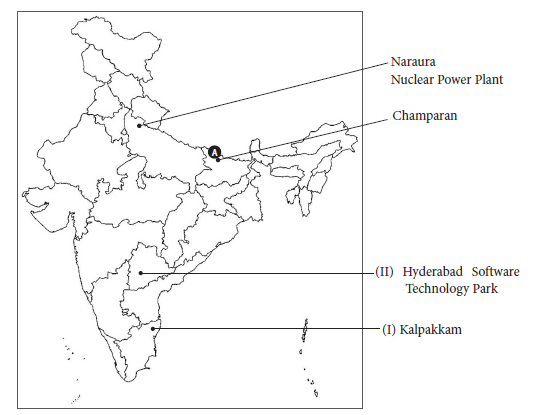Please refer to Class 10 Social Science Sample Paper Term 2 Set B with solutions below. The following CBSE Sample Paper for Class 10 Social Science has been prepared as per the latest pattern and examination guidelines issued by CBSE. By practicing the Social Science Sample Paper for Class 10 students will be able to improve their understanding of the subject and get more marks.
CBSE Class 10 Social Science Sample Paper for Term 2
SECTION – A
1. What is mass communication? What are the different means of mass communication? What is the significance of mass communication in a country like India?
Answer : Mass communication : It covers large number of people at the same time. Different means of mass communication are radio, television, films, internet, newspapers and magazines.
Significance of mass communication are :
(i) Covers more than 95% of India’s total population
(ii) Provides education and entertainment
(iii) Most instant means of mass information
(iv) Brings all classes of people together.
2. What are the Special Economic Zones (SEZs)? Why is the government setting up SEZs?
Answer : SEZs or Special Economic Zones are industrial areas with world class facilities.
(i) Companies who set-up units in SEZs are exempted from tax for 5 years.
(ii) They are set-up to attract foreign investment.
3. State any three merits of democracy.
Answer : Merits of democracy are :
(i) Democracy assures equality in every sphere of life like political, social and economic.
(ii) It upholds basic individual liberties like freedom of speech, etc.
(iii) In a democracy transparency in governance is achieved.
4. Why are there a wide range of colours, hardness, crystal forms, lustre and density found in minerals?
Answer : The varied colours found in minerals are due to its chemical composition, and the parameters such as temperature, pressure, rate of cooling etc., present during its formation.
5. Explain any three effects of population growth in England in the later eighteenth century.
Answer : (i) Due to pressure from industrialists, government was forced to remove corn laws. Food is not imported in Britain.
(ii) Demand on food grains increased as urban centres expanded.
(iii) Due to pressure from landed groups government restricted import of corn by enacting corn laws.
SECTION – B
6. “Transparency is the most important feature of democracy.” Analyse.
OR
“Democracy is best suited to produce better results”. Examine the statement.
Answer : Transparency is the most important feature of democracy :
(i) Democracy ensures that decision-making will be based on certain norms and procedures.
(ii) So, a citizen who wants to know if a decision was taken through correct procedures can find this out by filing R.T.I.
(iii) The citizens have the right and the means to examine the process of decision-making. This is known as transparency.
OR
Democracy is best suited to produce its own outcomes :
(i) Promotes equality and coexistence among citizens.
(ii) Enhances the dignity and freedom of the individual.
(iii) Improves the quality of decision making in spite of many economic, political and social problems.
(iv) Provides a method to resolve conflicts. Allow room to correct mistakes.
(v) Believes in discussion, negotiation and shows accountability through transparency.
7. How do Multinational corporations (MNCs) interlink production across countries? Explain with examples.
Answer : There are varieties of ways in which the MNCs establish their production in different countries across the globe.
They set up partnership with local companies by using the local companies for supplies, by closely competing with the local companies or buying them.
They procure the raw materials locally in large quantities and at cheap rates from various locations. Gradually they integrate the locations and achieve “economies of scale”.
Example – Cargill Foods taking over Parakh Food.
8. Mention any three effects of the British Government’s decision for the abolition of the Corn Laws.
Answer : (i) Food could be imported into Britain at much cheaper rate than it was produced within the country.
(ii) British agriculture was unable to compete with imports. Vast areas of land were left uncultivated and people started migrating to cities or other countries.
(iii) As food prices fell, consumption in Britain rose. Faster industrial growth in Britain also led to higher incomes and therefore more food imports.
(iv) Around the world in Eastern Europe, Russia, America, and Australia, lands were cleared and food production expanded to meet the British demand.
SECTION – C
9. What is liberalisation? Describe any four effects of liberalisation on the Indian economy.
OR
“Information and communication technology has played a major role in spreading out production of services across countries.” Justify the statement with examples.
Answer : Liberalisation means the opening of the country for foreign investments and capitals. Trade barriers are often used by countries to protect the domestic industries from the products of other countries. It has led to dismantling of the trade barriers.
Free trade benefits consumers through increased choices and reduced prices. On the other hand, free flow of capital ensures that any country can make investments in other countries.
Impacts:
(i) Increase in the foreign trade leading to better foreign reserves.
(ii) Increase in foreign investment.
(iii) Exchange of technology between countries, has led to improvement in production in domestic companies. Also, competition from MNCs makes the Indian companies perform better.
(iv) Foreign companies (MNCs) can now setup factories and offices in India to boost their production for the global markets. Many MNCs now export products that has been manufactured in India.
(v) Better means of communication have developed alongside globalisation, which facilitates trading activities.
OR
Rapid improvement in information and communication technology has stimulated the globalisation process.
(i) While transportation technology has made much faster delivery of goods across long distances at lower costs, this would not have been possible without IT.
(ii) There have been remarkable development in information and communication technology.
(iii) Telecommunication and interest facilities are used to contact one another around the world, to access information instantly, and to communicate from remote areas.
(iv) Through internet, one can obtain and share
information. It also allows to send e-mail and talk across the world at negligible costs.
(v) For example, a news magazine published for Mumbai readers can be designed and printed in Delhi office. The designers in the Delhi office get order on how to design the magazine from the office in Mumbai using internet facilities. The designing is done on a computer and sent to Mumbai. The printing is done in Mumbai.
Even the payment of money for designing from a bank in Mumbai to a bank in Delhi is done instantly through net-banking.
10. “Modern democracies cannot exist without political parties.” Examine the statement.
OR
Explain any three merits of democratic governments over the dictatorship.
Answer : In all the democracies, citizens have rights but they should be able to claim these rights.
(i) When the elected political parties become the ruling party then they give these rights to the citizens legally and practically.
(ii) In all the democracies, people need good governance, for this we need political parties which contest in elections.
(iii) The society needs rapid development, this work is done by the political parties. They can introduce many new policies and program for the welfare of the citizens.
(iv) The Opposition political party also plays a vital role by finding mistakes in the work of the ruling party so that the development stays on course.
(v) If there were no political parties in such cases we would only have independent candidates contesting election with individual agenda and not a national agenda.
(vi) The rise of political parties is directly linked to the emergence of representative democracies. Large societies need a way to bring various representatives together so that a responsible government could be formed.
We can say that parties are a necessary condition for a democracy.
OR
Advantages of democracy :
(i) Chief merit of democracy lies in the fact that it safeguards the interests of the people. Real power lies in the hands of the people who exercise it by the representatives elected by them and who are responsible to them. The social, economic and political interests of the individuals are served better under this system.
(ii) Democracy is based on the principle of equality. All members of the state are equal in the eyes of law. All enjoy equal social, political and economic rights and state cannot discriminate among citizens on the basis of caste, religion, sex, or property. All have equal right to choose their government.
(iii) Democracy is known for its stability, firmness and efficiency. The tenure of the elected representatives is fixed. They form a stable government because it is based on public support. The administration is conducted with a sense of responsibility.
Demerits of dictatorship :
(a) In dictatorship a very select few rule over the country and they are nor answerable to the public. There is no chance of correcting a wrong policy or a decision.
(b) Since people have no say in the government functioning there is large scale dissatisfaction. The rulers generally use suppressive and coercive measures to keep the population from revolting.
SECTION – D
11. Read the given text and answer the following questions.
Railways are the principal mode of transportation for freight and passengers in India. Railways also make it possible for people to conduct multifarious activities like business, sightseeing, pilgrimage along with transportation of goods over longer distances. Apart from an important means of transport the Indian Railways have been a great integrating force for more than 150 years.
Railways in India bind the economic life of the country as well as accelerate the development of the industry and agriculture. The Indian Railway have a network of 7,137 stations spread over a route length of 66,687 km with a fleet of 11,122 locomotives, 54,506 passenger service vehicles, 6,899 other coach vehicles and 2,51,256 wagons as on March 2016. The Indian Railway is now reorganized into 16 zones.
11.1 What is the importance of rail transport in India?
Answer : Railways are the principal mode of transportation for freight and passengers in India. It helps in various activities such as business, sightseeing and pilgrimage. It also helps in transportation of goods over longer distances. They have been a great integrating force for more than 150 years.
11.2 How has railways helped the economy of India?
Answer : Railways in India bind the economic life of the country as well as accelerate the development of the industry and agriculture.
11.3 How big is the Indian Railway?
Answer : Indian Railway connects over 7137 stations. It divided into 18 zones. It is India’s largest public sector undertaking.
12. Read the given text and answer the following questions.
The world changed profoundly in the nineteenth century. Economic, political, social, cultural and technological factors interacted in complex ways to transform societies and reshape external relations.
Economists identify three types of movement of ‘flows’ within international economic exchanges. The first is the flow of trade which in the nineteenth century referred largely to trade in goods (e.g., cloth or wheat). The second is the flow of labour – the migration of people in search of employment. The third is the movement of capital for short-term or long-term investments over long distances.
All three flows were closely interwoven and affected peoples’ lives more deeply now than ever before. The interconnections could be sometimes be broken – for example, labour migration was often more restricted than goods or capital flow.
12.1 Why did people migrate in the nineteenth century?
Answer : People migrated in search of employment.
12.2 What were the factors that transformed societies in 19th century?
Answer : In 19 century, economic, political, social, cultural and technological factors interacted in complex ways to transform societies.
12.3 Define the types of movement or ‘flows’ within international economic exchange.
Answer : Economist identify three types of movement or ‘flows’ within international economic exchanges.
(i) The flow of trade which referred largely to trade in goods (e.g., cloth or wheat).
(ii) The flow of labour, people migrate in search of employment.
(iii) The movement of capital for short-term or long- term investments over long distances.
SECTION – E
13. 13.1 On the given outline Political Map of India, identify the place marked as A with the help of following information and write its correct name on the line marked near it.
(A) A place where movement of indigo farmers took place.
13.2 On the same given map of India, locate the following :
(I) A nuclear power plant in Tamil Nadu.
OR
Naraura Nuclear Power Plant
(II) Hyderabad Software Technology Park
Answer :


